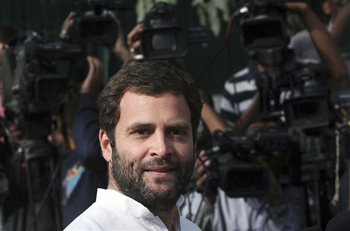 Jaipur, Jan 20: After months of anticipation and clamour within the Congress, Rahul Gandhi has been appointed Vice President, as the party gets battle-ready for the general elections scheduled for 2014.
Jaipur, Jan 20: After months of anticipation and clamour within the Congress, Rahul Gandhi has been appointed Vice President, as the party gets battle-ready for the general elections scheduled for 2014.
Mr Gandhi is now officially No 2 in the Congress. His boss is his mother, Congress president Sonia Gandhi. Accepting the new role, Mr Gandhi said on Saturday, "I have great experience ...this is great party and we can transform this country."
The All India Congress Committee will hold a day-long session today on the third and final day of its Jaipur conclave. Mr Gandhi along with Sonia Gandhi and Prime Minister Manmohan Singh are expected to address the gathering there.
Mr Gandhi's appointment was endorsed at the Congress' highest decision-making body, its working committee or the CWC, which met on Saturday evening at the end of a two-day brainstorming session in Jaipur.
Defence Minister AK Antony moved the proposal at the CWC which received unanimous endorsement.
"CWC accepted the proposal and after their endorsement, Mrs Sonia Gandhi also gave her approval and Shri Rahul Gandhi accepted this responsibility," Congress spokesperson Janardhana Dwivedi said.
The party was quick to emphasise that Mrs Gandhi will continue to play a bigger role. "There is a younger India and we are the first party to include the youth. Sonia Gandhi is the supreme leader and she will help with decisions. She has a bigger role," Congress leader Sandeep Dikshit said.
Mr Gandhi was already assigned to leading the party's strategy when the Congress asks voters for a third shot in power. But the Congress said on Saturday that the party will decide the PM candidate later. "Mrs Gandhi has rightly appointed Rahul Gandhi to the post of vice president. And as far as the prime ministerial post is concerned the party would decide about it later," said Congress' Sachin Pilot.
The Congress said Mr Gandhi's promotion represents its commitment to representing the youth of the country. He is 41 and in states like UP and Bihar, his lead role in elections did not yield any real dividends for the party.
The substantial presence of young delegates at the Jaipur session is seen as a sign of Mr Gandhi's increasing influence on the party. In her speech on Friday, his mother emphasised an urgent need to address an alienation from the urban middle class, especially the youth.
Recently, the Congress responded clumsily when thousands of students protested for weeks against the gang-rape of a young student on a moving bus in Delhi.
Demonstrations demanded justice for the victim and better security for women, and there was huge anger at the failure of senior ministers to reach out to the protesters.





Comments
Add new comment